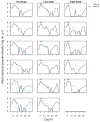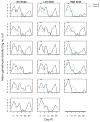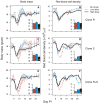Chemotherapy, within-host ecology and the fitness of drug-resistant malaria parasites
- PMID: 20584075
- PMCID: PMC3066636
- DOI: 10.1111/j.1558-5646.2010.01068.x
Chemotherapy, within-host ecology and the fitness of drug-resistant malaria parasites
Abstract
A major determinant of the rate at which drug-resistant malaria parasites spread through a population is the ecology of resistant and sensitive parasites sharing the same host. Drug treatment can significantly alter this ecology by removing the drug-sensitive parasites, leading to competitive release of resistant parasites. Here, we test the hypothesis that the spread of resistance can be slowed by reducing drug treatment and hence restricting competitive release. Using the rodent malaria model Plasmodium chabaudi, we found that low-dose chemotherapy did reduce competitive release. A higher drug dose regimen exerted stronger positive selection on resistant parasites for no detectable clinical gain. We estimated instantaneous selection coefficients throughout the course of replicate infections to analyze the temporal pattern of the strength and direction of within-host selection. The strength of selection on resistance varied through the course of infections, even in untreated infections, but increased immediately following drug treatment, particularly in the high-dose groups. Resistance remained under positive selection for much longer than expected from the half life of the drug. Although there are many differences between mice and people, our data do raise the question whether the aggressive treatment regimens aimed at complete parasite clearance are the best resistance-management strategies for humans.
© 2010 The Author(s). Journal compilation © 2010 The Society for the Study of Evolution.
Figures










Similar articles
-
Rapid response to selection, competitive release and increased transmission potential of artesunate-selected Plasmodium chabaudi malaria parasites.PLoS Pathog. 2014 Apr 24;10(4):e1004019. doi: 10.1371/journal.ppat.1004019. eCollection 2014 Apr. PLoS Pathog. 2014. PMID: 24763470 Free PMC article.
-
The fitness of drug-resistant malaria parasites in a rodent model: multiplicity of infection.J Evol Biol. 2011 Nov;24(11):2410-22. doi: 10.1111/j.1420-9101.2011.02369.x. Epub 2011 Aug 23. J Evol Biol. 2011. PMID: 21883612 Free PMC article.
-
Competitive release and facilitation of drug-resistant parasites after therapeutic chemotherapy in a rodent malaria model.Proc Natl Acad Sci U S A. 2007 Dec 11;104(50):19914-9. doi: 10.1073/pnas.0707766104. Epub 2007 Dec 3. Proc Natl Acad Sci U S A. 2007. PMID: 18056635 Free PMC article.
-
Fitness of drug-resistant malaria parasites.Acta Trop. 2005 Jun;94(3):251-9. doi: 10.1016/j.actatropica.2005.04.005. Epub 2005 Apr 18. Acta Trop. 2005. PMID: 15845348 Review.
-
Folic acid supplementation and malaria susceptibility and severity among people taking antifolate antimalarial drugs in endemic areas.Cochrane Database Syst Rev. 2022 Feb 1;2(2022):CD014217. doi: 10.1002/14651858.CD014217. Cochrane Database Syst Rev. 2022. PMID: 36321557 Free PMC article.
Cited by
-
Antibiotics can be used to contain drug-resistant bacteria by maintaining sufficiently large sensitive populations.PLoS Biol. 2020 May 15;18(5):e3000713. doi: 10.1371/journal.pbio.3000713. eCollection 2020 May. PLoS Biol. 2020. PMID: 32413038 Free PMC article.
-
Rapid response to selection, competitive release and increased transmission potential of artesunate-selected Plasmodium chabaudi malaria parasites.PLoS Pathog. 2014 Apr 24;10(4):e1004019. doi: 10.1371/journal.ppat.1004019. eCollection 2014 Apr. PLoS Pathog. 2014. PMID: 24763470 Free PMC article.
-
Does High-Dose Antimicrobial Chemotherapy Prevent the Evolution of Resistance?PLoS Comput Biol. 2016 Jan 28;12(1):e1004689. doi: 10.1371/journal.pcbi.1004689. eCollection 2016 Jan. PLoS Comput Biol. 2016. PMID: 26820986 Free PMC article.
-
Consequences of immunopathology for pathogen virulence evolution and public health: malaria as a case study.Evol Appl. 2011 Mar;4(2):278-91. doi: 10.1111/j.1752-4571.2010.00178.x. Evol Appl. 2011. PMID: 25567973 Free PMC article.
-
Relevance of undetectably rare resistant malaria parasites in treatment failure: experimental evidence from Plasmodium chabaudi.Am J Trop Med Hyg. 2015 Jun;92(6):1214-21. doi: 10.4269/ajtmh.15-0036. Epub 2015 May 4. Am J Trop Med Hyg. 2015. PMID: 25940195 Free PMC article.
References
-
- A-Elbasit IE, ElGhazali G, A-Elgadir TME, Hamad AA, Babiker HA, Elbashir MI, Giha HA. Allelic polymorphism of MSP2 gene in severe P. falciparum malaria in an area of low and seasonal transmission. Parasitol Res. 2007;102:29–34. - PubMed
-
- Abdel-Muhsin AMA, Mackinnon MJ, Ali E, Nassir EKA, Suleiman S, Ahmed S, Walliker D, Babiker HA. Evolution of drug-resistance genes in Plasmodium falciparum in an area of seasonal malaria transmission in Eastern Sudan. J Infect Dis. 2004;189:1239–1244. - PubMed
-
- Ali E, Mackinnon MJ, Abdel-Muhsin AMA, Ahmed S, Walliker D, Babiker HA. Increased density but not prevalence of gametocytes following drug treatment of Plasmodium falciparum. Trans R Soc Trop Med Hyg. 2006;100:176–183. - PubMed
-
- Arnot DE. Clone multiplicity of Plasmodium falciparum infections in individuals exposed to variable levels of disease transmission. Trans R Soc Trop Med Hyg. 1998;92:580–585. - PubMed
-
- Babiker HA. Seasonal fluctuation of drug-resistant malaria parasites: a sign of fitness cost. Trends Parasitol. 2009;25:351–352. - PubMed
Publication types
MeSH terms
Substances
Grants and funding
LinkOut - more resources
Full Text Sources
Other Literature Sources
Medical
